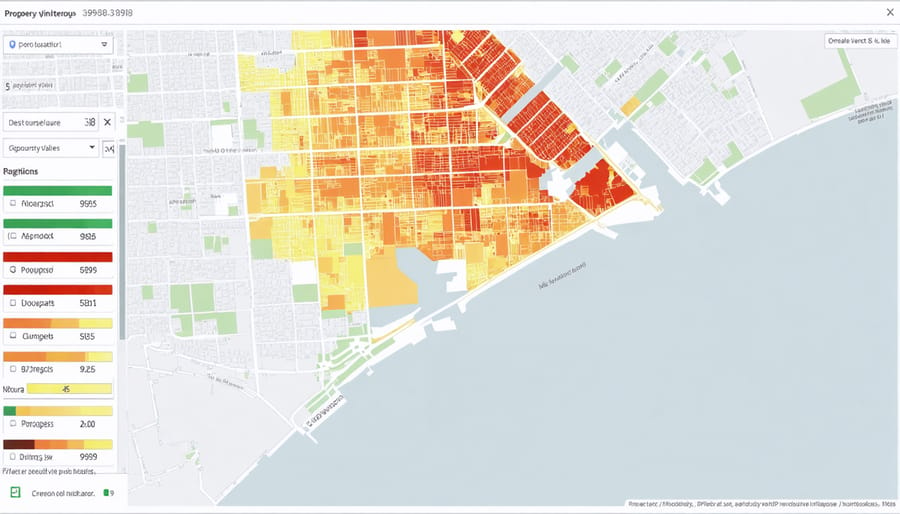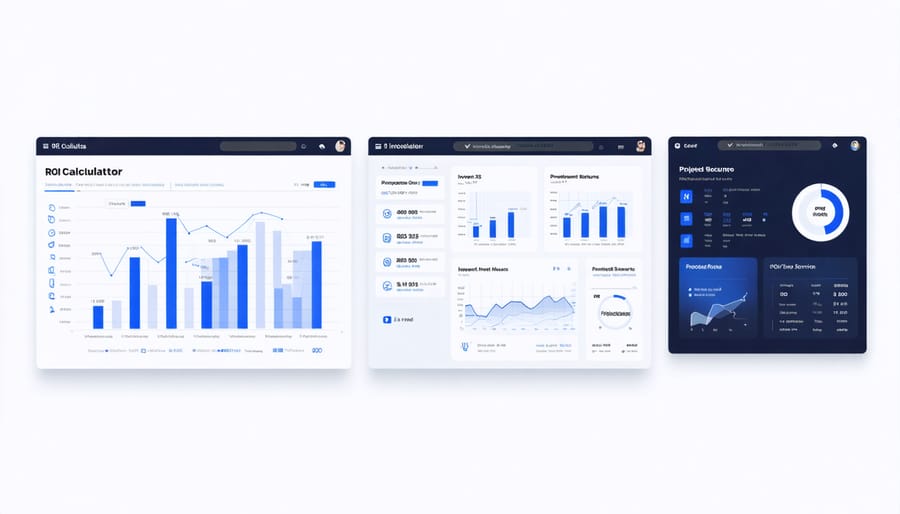Transform real estate decision-making through advanced market analysis tools that deliver precise valuations, demographic insights, and investment forecasting. Today’s data-driven market analysis strategies demand sophisticated technological solutions to maintain competitive advantage in an increasingly complex marketplace.
Professional real estate analysts leverage comprehensive platforms combining artificial intelligence, machine learning, and big data analytics to evaluate property values, market trends, and investment opportunities with unprecedented accuracy. These tools synthesize multiple data sources – from traditional MLS listings to alternative datasets like social media sentiment and satellite imagery – providing real-time insights that drive informed investment decisions.
Leading firms integrate these analytical platforms with predictive modeling capabilities, enabling professionals to forecast market movements, identify emerging opportunities, and quantify risk factors across diverse property portfolios. This technology-driven approach to market analysis has become essential for maintaining competitive edge in today’s dynamic real estate environment, where rapid decision-making based on accurate data analysis can mean the difference between success and missed opportunities.

Advanced Data Analytics Platforms
Predictive Analytics Tools
Modern predictive analytics has revolutionized how professionals approach market analysis, with sophisticated real estate intelligence tools leveraging artificial intelligence and machine learning algorithms to forecast market trends with unprecedented accuracy.
Leading platforms like HouseCanary and Enodo utilize advanced algorithms to analyze thousands of data points, including historical property values, demographic shifts, economic indicators, and local market conditions. These tools can predict property valuations, rental rates, and market movements with accuracy rates approaching 90% in stable markets.
AI-powered forecasting systems excel at identifying emerging market patterns by processing vast amounts of unstructured data from multiple sources, including social media sentiment, building permit applications, and transportation development plans. This comprehensive analysis enables professionals to anticipate market shifts months or even years in advance.
Notable features of modern predictive analytics tools include:
– Machine learning models that continuously improve accuracy through real-time data updates
– Scenario modeling capabilities for testing different market conditions
– Granular neighborhood-level analysis
– Integration with GIS data for location-specific insights
– Risk assessment algorithms for investment decision support
These sophisticated tools have become essential for professionals seeking to make data-driven decisions in increasingly complex market environments. By combining traditional market metrics with AI-powered insights, analysts can develop more robust and reliable market strategies.
Property Valuation Systems
Modern property valuation systems have revolutionized how real estate professionals assess market values, incorporating sophisticated algorithms and comprehensive data analysis. Automated Valuation Models (AVMs) utilize machine learning algorithms to process multiple property valuation factors, including historical sales data, neighborhood trends, and property characteristics to generate accurate valuations within minutes.
These systems typically integrate with Multiple Listing Service (MLS) databases, providing real-time access to comparable property data and market trends. Advanced comparative market analysis (CMA) tools enable professionals to generate detailed reports that consider both quantitative and qualitative factors, such as property condition, location attributes, and recent market activity.
Notable features of contemporary valuation systems include:
– Predictive analytics for future value projections
– Integration with geographic information systems (GIS)
– Adjustment algorithms for property differences
– Customizable reporting capabilities
– Mobile accessibility for on-site assessments
Industry-leading platforms now incorporate artificial intelligence to refine valuation accuracy continuously, learning from new market data and transaction outcomes. This technological evolution has significantly reduced the time required for property valuations while maintaining high accuracy standards. However, professional judgment remains crucial in interpreting and validating system-generated assessments, particularly for unique properties or rapidly changing markets.
Geographic Information Systems (GIS)
Heat Mapping Technologies
Heat mapping technologies have revolutionized how real estate professionals visualize and analyze market trends across geographical areas. These sophisticated tools aggregate property data, market statistics, and demographic information to create color-coded visual representations of various metrics, enabling quick identification of market patterns and opportunities.
Modern heat mapping platforms integrate multiple data sources, including property values, sale prices, rental rates, and market activity levels. The resulting visualizations help professionals identify emerging neighborhoods, investment opportunities, and areas experiencing significant value appreciation or decline. Advanced systems can layer additional data points such as population growth, income levels, and development permits to provide comprehensive market insights.
Leading platforms offer customizable views that allow users to adjust time periods, zoom levels, and data parameters to suit specific analysis needs. Real-time updates ensure that visualizations reflect current market conditions, while historical data tracking enables trend analysis and forecasting. Many systems now incorporate machine learning algorithms to predict future hot spots and market movements.
For maximum utility, these tools often feature exportable reports, collaborative sharing capabilities, and integration with other market analysis platforms. This interconnectivity ensures that heat mapping insights can be effectively incorporated into broader market research and investment strategies.

Location Intelligence Solutions
Location intelligence solutions have revolutionized how real estate professionals analyze market potential and make informed investment decisions. These sophisticated tools combine geographic information systems (GIS) with demographic data to provide comprehensive insights into location-specific market dynamics.
Leading platforms like CoStar and Esri Business Analyst offer detailed demographic analysis, including population trends, income levels, and consumer behavior patterns within specific radius parameters. These insights help developers and investors understand the target market’s composition and purchasing power.
Advanced location intelligence tools also evaluate proximity to key amenities, transportation hubs, and competing properties. They generate heat maps showing foot traffic patterns, vehicle counts, and population density, enabling professionals to assess a location’s accessibility and visibility potential.
Development potential analysis is enhanced through zoning overlay tools that display current land use restrictions, future development plans, and potential regulatory challenges. These platforms often integrate with municipal databases to provide real-time updates on building permits, code changes, and urban development initiatives.
Modern location intelligence solutions also incorporate predictive analytics, using historical data and machine learning algorithms to forecast neighborhood changes, property value trends, and emerging market opportunities. This forward-looking capability helps professionals identify areas with strong growth potential before they become obvious to the broader market.
Market Research and Analysis Platforms
Investment Analysis Tools
Investment analysis tools serve as the backbone of informed real estate decision-making, offering sophisticated capabilities for evaluating potential returns and risks. Modern ROI calculators have evolved beyond simple mathematics to incorporate multiple variables, including property appreciation rates, maintenance costs, financing terms, and market dynamics.
Industry-leading platforms like CoStar and ARGUS provide comprehensive investment scenario modeling, enabling professionals to simulate various market conditions and investment strategies. These tools can generate detailed cash flow projections, calculate key metrics such as IRR (Internal Rate of Return), NOI (Net Operating Income), and cap rates, while accounting for complex variables like tenant rollover and market volatility.
Advanced modeling platforms now incorporate machine learning algorithms to enhance accuracy in predicting market trends and property performance. These systems can analyze historical data patterns, current market conditions, and economic indicators to provide more reliable investment forecasts.
For construction professionals and developers, specialized tools offer construction cost analysis integration, allowing for comprehensive evaluation of development projects from acquisition through completion. These platforms can model different construction scenarios, timeline variations, and their impact on overall investment returns.
Risk assessment features have become increasingly sophisticated, with tools now capable of stress-testing investment scenarios against various economic conditions, interest rate fluctuations, and market downturns. This capability enables investors to better understand potential vulnerabilities and adjust their strategies accordingly.

Market Trend Tracking Systems
Market trend tracking systems have become indispensable tools for construction and real estate professionals seeking to make data-driven decisions. These sophisticated platforms aggregate and analyze multiple data points to provide real-time insights into current market trends, enabling professionals to stay ahead of market shifts and optimize their investment strategies.
Leading platforms like CoStar, Zillow Analytics, and Realtors Property Resource (RPR) offer comprehensive monitoring capabilities for price movements, property inventory fluctuations, and broader market conditions. These systems typically feature customizable dashboards that display key metrics such as median price changes, days on market, absorption rates, and supply-demand ratios across different property segments and geographic areas.
Advanced tracking systems incorporate machine learning algorithms to identify patterns and predict potential market shifts. They analyze historical data alongside current market indicators to generate forecasting models, helping professionals anticipate market movements and adjust their strategies accordingly.
Integration capabilities with MLS databases and public records ensure that these systems maintain up-to-date information, while automated reporting features streamline the process of sharing market intelligence with stakeholders. Many platforms also offer mobile accessibility, enabling professionals to monitor market conditions and receive alerts about significant changes while in the field.
Integration and Implementation Strategies
Successfully implementing real estate market analysis tools requires a strategic approach that balances organizational needs, technical capabilities, and resource allocation. Begin by conducting a thorough needs assessment to identify specific requirements and pain points within your current analysis process. This evaluation should consider factors such as data volume, analysis complexity, and reporting frequency.
When selecting tools, prioritize solutions that integrate seamlessly with existing systems and workflows. Key considerations include compatibility with your current Customer Relationship Management (CRM) system, property management software, and accounting platforms. Ensure the chosen tools support industry-standard data formats and offer robust API capabilities for future scalability.
Create a phased implementation plan that includes:
1. Initial setup and configuration
2. Data migration and validation
3. User training and documentation
4. Testing and quality assurance
5. Performance monitoring and optimization
Establish clear success metrics before implementation, such as reduced analysis time, improved accuracy in market predictions, or enhanced reporting capabilities. These benchmarks will help measure ROI and justify technology investments to stakeholders.
For successful adoption, designate implementation champions within your organization who can guide teams through the transition. These individuals should understand both the technical aspects and business applications of the chosen tools. Provide comprehensive training programs tailored to different user groups, from basic functionality for occasional users to advanced features for power users.
Consider data security and compliance requirements throughout the implementation process. Ensure tools meet industry standards for data protection and maintain appropriate access controls. Document data handling procedures and establish regular security audits.
To maximize tool effectiveness, develop standardized processes for:
– Data input and verification
– Analysis workflows
– Report generation and distribution
– Regular system maintenance
– Performance optimization
Regular evaluation of tool performance and user feedback helps identify areas for improvement and ensures continued alignment with business objectives. Schedule periodic reviews to assess tool utilization, identify training needs, and explore new features or capabilities that could benefit your organization.
Maintain strong relationships with vendors and service providers to ensure proper support and timely updates. Consider establishing service level agreements (SLAs) that outline expected response times and support coverage.
Remember that successful implementation is an ongoing process rather than a one-time event. Stay informed about industry trends and emerging technologies to ensure your analysis tools remain current and effective in meeting evolving market demands.
Real estate market analysis tools have revolutionized how industry professionals approach property valuation, investment decisions, and market forecasting. These technological solutions have proven invaluable in streamlining workflows, reducing human error, and providing data-driven insights that were previously difficult to obtain.
The integration of artificial intelligence and machine learning capabilities continues to enhance the accuracy of predictive analytics, while cloud-based platforms ensure accessibility and real-time collaboration among team members. The demonstrated ROI of these tools, through improved decision-making and risk management, has made them essential components of modern real estate operations.
Looking ahead, we can expect further advancements in several key areas. Predictive analytics will become more sophisticated, incorporating an ever-wider range of data points and market indicators. Virtual and augmented reality features will enhance property visualization and analysis capabilities, while blockchain technology may revolutionize property data verification and transaction processes.
The future of real estate market analysis tools lies in their ability to provide increasingly personalized insights while maintaining robust data security and compliance standards. As these tools continue to evolve, successful professionals will be those who effectively leverage these technologies to gain competitive advantages in their markets.
For construction and real estate professionals, staying current with these technological advances and understanding their practical applications will be crucial for maintaining market leadership and ensuring sustainable growth in an increasingly data-driven industry.

